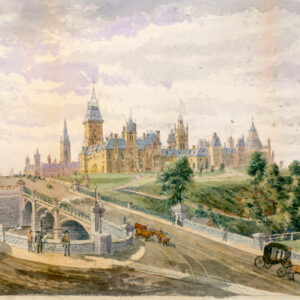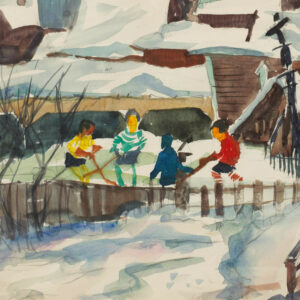-
Nakamura, Kazuo (Canadian, 1926–2002)
A member of Painters Eleven, Nakamura embraced science and nature in his early abstract landscapes. Later, he created a body of work known as the Number Structures, which explores the connections between mathematics and aesthetics. The Art Gallery of Ontario in Toronto held a posthumous retrospective of his work in 2004. (See Kazuo Nakamura: Life & Work by John G. Hatch.)
-
Nash, Paul (British, 1889–1946)
Nash was a landscape painter whose semi-abstract scenes drew on the work of Italian artist Giorgio de Chirico and the Surrealists. He founded the British art group Unit One in 1933 to promote modernist art, architecture, and design in England and was one of the organizers of the International Surrealist Exhibition in London, U.K., in 1936. Nash was an official British war artist in both world wars.
-
Nichols, Jack (Canadian, 1921–2009)
An official war artist with the Canadian Navy during the Second World War, Nichols depicted the D-Day invasion as part of the Canadian contingent that landed near Brest, France. After the war, he received a Guggenheim Fellowship and later taught at the University of British Columbia and the University of Toronto. Nichols was known for his melancholy drawings and lithographs and was one of several artists to represent Canada at the 1958 Venice Biennale.
-
Nicolas, Louis (French, 1634–post-1700)
A Jesuit missionary in New France and creator of the illustrated manuscript Codex Canadensis, which depicts the flora, fauna and Indigenous inhabitants of New France in a style different from official art of Nicolas’s time. The Codex contains notably accurate details about birds and other animals, as well as imaginary creatures such as a unicorn and a sea monster. (See Louis Nicolas: Life & Work by François-Marc Gagnon.)
-
Noganosh, Ron (Anishinābe, 1949–2017)
An Anishinābe sculptor and assemblage artist from Magnetewan First Nation in Ontario who co-founded the Aboriginal Curatorial Collective (now the Indigenous Curatorial Collective) in 2006. Noganosh trained as a welder and graphic artist before studying fine arts at the University of Ottawa. His pioneering assemblage works transformed readymade commercial materials such beer cans and caps into sculptural objects rich with humour, symbolism, and cultural commentary.
-
Notman, William (Scottish/Canadian, 1826–1891)
After immigrating to Canada in 1856, Notman soon became Montreal’s most prominent photographer. He specialized in portraits and developed innovative techniques to portray many people in a single photograph (known as a composite photograph) and to recreate outdoor scenes inside the studio. Thanks to his exceptional technical and promotional skills, he was the first Canadian photographer to build an international reputation. (See William Notman: Life & Work by Sarah Parsons.)
-
 About the Author
About the Author
Jim Burant is an Adjunct Professor of Art History at Carleton University, as well as Director of the Ontario Region of the National Archival Appraisal Board of Canada.
-
 More Online Art Books
More Online Art Books
Read online or download the ACI’s incredible library of art books for free in French and English.
Learn More -
 Read from Beginning
Read from Beginning
From a rough and tumble lumber town, Ottawa has become a vibrant metropolitan centre with a centre of artistic excellence.
Learn More
